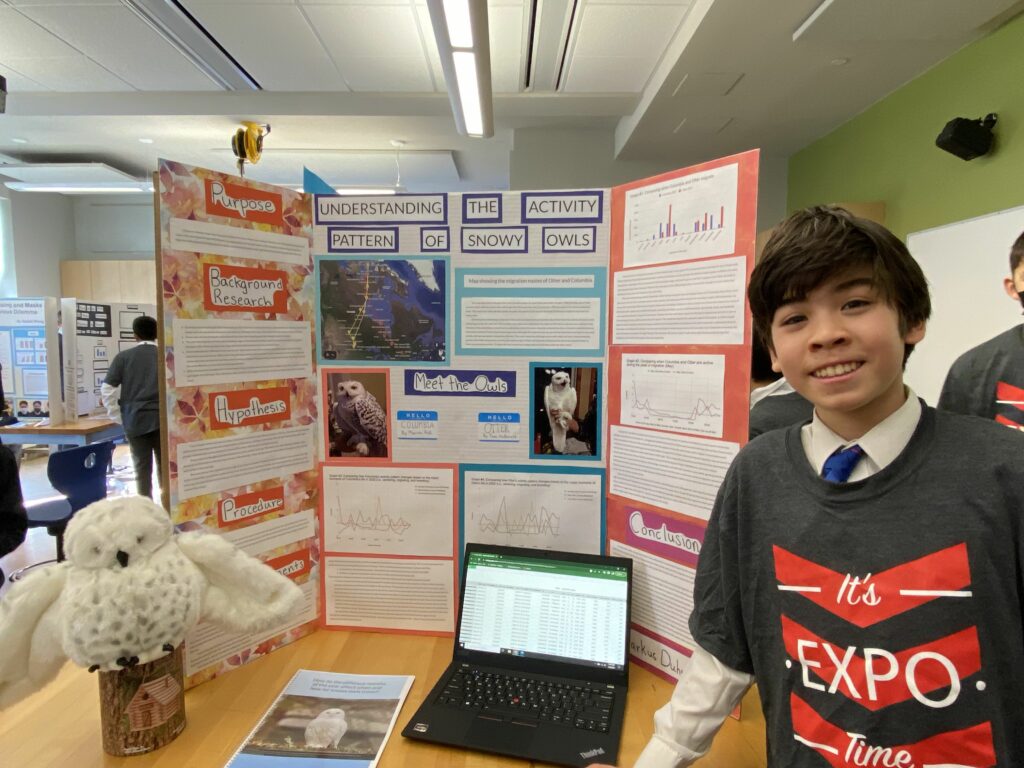
Markus Duhme with his science fair exhibit using Project SNOWstorm data. (©Christian Duhme)
Since Project SNOWstorm’s inception, all of us here have felt that since our work with snowy owls is funded entirely by the public, through hundreds of small donations every year, we want to make as much of our data publicly available as is possible. (And of course, as much as is prudent; as we’ve noted many times, all of our tracking data from currently tagged owls is release-delayed by 24 hours, to give the owls some space and security.)
Over the years, one of the most enjoyable ways we’ve shared the bounty has been with teachers and students, who from time to time ask if they can use some of our raw tracking data for classroom or science fair projects. We are always happy to oblige, with the obvious caveat that none of the projects lead to actual publication.
Rarely do middle school students take as deep a dive into the data pool, though, as did Markus Duhme, a seventh-grader from Vancouver, British Columbia. Markus got in touch with me in January, explaining that he wanted to focus his Wonder Expo (as his school calls its science fair) entry on two of our currently tagged owls, Otter and Columbia, comparing their movement patterns over a single year.
He reached out because his original approach had hit a snag — Markus had been laboriously obtaining the coordinates for each of the thousands of GPS points for each owl from its tracking map on our website (each map point, when clicked, shows the time, coordinates, flight speed and other information for that fix). Then he calculated the distance between that point and the previous one. That was a lot of work in and of itself, but his approach foundered when Markus got to the birds’ Arctic locations in the summer, when neither moved much, creating gigantic clusters of locations that made it impossible for him to easily separate individual fixes chronologically.
I was glad he asked for help, because it was a snap for me to download a .csv spreadsheet file with the complete movement record of each of the two owls, including coordinates for all the points. Once he had that more easily accessible information, Markus was off the races. Using some standard statistical approaches, he analyzed their movement patterns across months and on a time-of-day basis for each season, identifying significant differences between the behaviors of the two owls.
For example Otter, an adult male, had a much more compressed spring migration, taking place primarily in May, than did Columbia, an adult female, who spent the better part of three months moving north, with the bulk of her movements in April. Once in the Arctic, Columbia essentially stayed in place, apparently guarding a nest, while Otter moved more widely. On an hourly basis, Columbia remained all but motionless for the first half of the day during her incubation period, usually not stirring from the nest until early afternoon (though in the Arctic, with its 24-hour sunlight, terms like “early afternoon” have less meaning).
There was a lot more that Markus teased out for his exhibit, testing his hypothesis and explaining his results. He and his parents were kind enough to share a picture of the young scientist with his Wonder Expo display — congratulations, Markus!


11 Comments on “The Next SNOWstorm Generation?”
Hi,
Superb collaboration on your part and congratulations to Markus for his research.
This is so awesome! Markus’s achievement makes me just a little bit more hopeful about our future.
Well Done Marcus! Super
Well done young man!
Awesome, Marcus!! And, Scott, I wish I could read his exhibit!
I wish I were going to be alive long enough to watch Markus go on to college and if his interest in Snowy Owls continues, he could be part of our next generation of Project Snowstorm collaborators! Great job Markus!
Well done Markus!
If the work is rigorous enough for publication, even in a regional journal, help Markus write it up and give him a citable paper!
That’s great work Markus!!! Awesome to see this collaboration, it’s very encouraging too see the young generation take an interest in snowy owls and wildlife in general!!
I sure would like to hear his presentation on the International Owl Center ( in Minnisota) ‘s live stream lecture series! Good Job Project Snowstorm in mentoring the next generation!
Let’s go Markus!!!!! WAHOOO. – Herbert, Arjun, Max